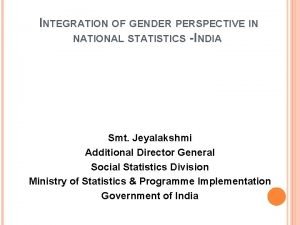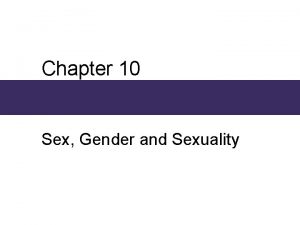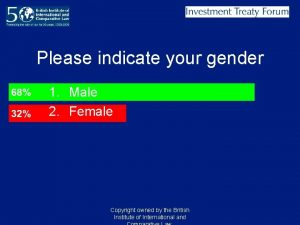Gender Cant live with them Cant live without




























































- Slides: 60

Gender “Can’t live with them… Can’t live without them…” A. Kent Van Cleave, Jr. , Ph. D.

Gender Objectives: Understand… • …gender as a social category • …gender stereotyping and its pitfalls. • …the role of socialization and media in gender stereotyping. • …the factors that activate gender stereotypes • …gender roles and gender identity • …the role of socialization and media in gender roles and gender identity.


Gender Objectives: Understand… • …gender identity and disorders of gender identity. • …the concepts of masculinity, femininity, androgyny, and research on these constructs. • …the relationship between masculinity, femininity, androgyny, and psychological well-being.

Gender Objectives: Understand… • …the major theoretical perspectives on gender and social behavior. • …the contribution of biology to gender differences. • …the contribution of socialization to gender differences. • …the contribution of the interaction of these factors to gender differences.

Gender Objectives: Understand… • …the effects of social roles on gender differences in behavior and behavioral expectations. • …the effects of social situations on gender differences in behavior and behavioral expectations. • …gender differences in aggression, conformity, nonverbal communication, sexuality, and the sense of personal entitlement. • Discuss the changing roles of women in our culture.

Gender vs. Sex: anatomical and physiological differences between males and females that are genetically determined (purely biological) Gender: Anything else associated with an individual’s sex: roles, behaviors, preferences, identifty, etc. (not biological)

Gender Stereotyping

Gender Stereotyping

Gender Stereotyping

Gender Stereotyping • We immediately gender type individuals when we meet or encounter them. • (We also type them in other ways, such as by race, age, etc. ) • This calls up our gender (and other) stereotypes. • Our stereotypes shape our interactions and our future impressions of the individual. • Gender ambiguity subject of humor…

Gender Stereotyping Learning Gender Stereotypes • We teach children about gender from birth. – Names – Dress – Toy selection – Behaviors we encourage or discourage. • This shaping communicates gender stereotypes, gender identity and gender roles.

Gender Stereotyping Learning Gender Stereotypes • Media depictions of gender also communicate these. – Men appear more often as experts; women appear more often as recipients of expert advice or as caregivers. – Media images focus more on men’s heads, more on women’s bodies. – Females are slightly under-represented. – Men behave more aggressively in ads.

Gender Stereotyping Gender Subtypes • We also subtype the genders in a number of ways – Gender role subtypes (mother, beauty queen, blonde, father, hardhat, jock) – Racial subtypes – Age-related subtypes (crone, coot)

Gender Stereotyping Stereotype activation—determinants of whether we relate to a person largely on the basis of gender stereotype or as an individual include… • Amount of information • Salience of group membership • Relative power of other relevant stereotypes

Gender Stereotyping Stereotype activation and Amount of Information • The less information we have on the individual, the more likely we are to respond on the basis of stereotype. • We can reduce stereotypic responding of others by providing more information about ourselves (priming).

Gender Stereotyping Stereotype activation and Amount of Information • Some males like to log onto chat rooms and pose as females. They tend to be responded to as if they were female. • (and vice versa)

Gender Stereotyping Stereotype activation and Salience of Group Membership • Salience refers to the extent to which the other’s gender stands out in the context. • For one male in a group of women, gender is more salient with respect to how others perceive him than if he were one of several males. • Amount and type of interaction also…

Gender Stereotyping Stereotype activation and relative power • A person in a position of higher power and status is more likely to respond on the basis of stereotypes than is a person of similar or less status. • Managers and supervisors are more likely to respond and evaluate on the basis of stereotypes than are followers.

Gender Stereotyping Stereotype activation and relative power • Many gender stereotypes focus on mental abilities. • Women are thought to be better at language, and language-related subjects. • Men are thought to be better at math and science. • Recent research suggests that only one true difference remains: males are better at visual -spatial tasks.

Gender Stereotyping Pitfalls of Gender Stereotyping • Many stereotypes (and subtypes) are inaccurate • Many stereotypes overgeneralize • Stereotypes are used to justify prejudice and discrimination. • Stereotypes exaggerate gender differences. • Stereotypes create self-fulfilling prophecy.

Gender Stereotyping Pitfalls of Gender Stereotyping • Gender stereotyping affects both performance evaluation and selection of employees. Factors affecting this: • The gender typing of the job. • Amount of information available about the individual. These effects typically are very small in experimental research, may be larger in life.

Gender and Self Gender Identity and Gender Consistency • Knowledge and acceptance that we are male or female… • We sex type children before birth (“It’s a girl. ”) • Until 4 or 5 we believe we can change gender. • We usually accept our gender identity as given.

Gender and Self Gender Identity • Some people do not accept their gender assignment, and are labeled as transsexual. – Usually biologically normal, but self-concept differs from physical gender. – Often surgically change sex and adopt the alternate gender identity.

Gender and Self Gender & Masculinity, Femininity, & Androgyny • Masculinity—extent to which a person believes s/he possesses characteristics typically associated with males in our culture. • Femininity—extent to which a person believes s/he possesses characteristics typically associated with females in our culture. • Androgyny—extent to which a person believes s/he possesses positive and/or negative characteristics of both genders.

Gender and Self Gender & Masculinity, Femininity, & Androgyny • Masculinity—Femininity are viewed as polar opposites in early research and gender conceptualizations. • Research scales used forced-choice of polar opposites for M-F scoring. • Androgyny—Based on this two-dimensional concept, androgyny means a person possesses characteristics of both genders and is high in neither.

Gender and Self Androgyny • Jung wrote that both males and females exhibit aspects of both masculinity and femininity. • Females exhibiting masculine characteristics, especially in work settings, are accepted. • Successful female managers often exhibit a lot of masculinity. • Males exhibiting feminine characteristics are not accepted as well.

Gender and Self Androgyny • Androgyny is probably more common among the more intelligent. • Androgyny probably increases as an individual ages.

Gender and Self Gender & Masculinity, Femininity, & Androgyny Bem hypothesized that persons “owning” masculine traits would perform better on “male” tasks, “owning” female traits would perform better on “female” tasks, and “owning” androgynous traits would do well in both situations. • Some limited experimental support found for this. • May be related to intelligence rather than androgyny.

Gender and Self Bem hypothesized that persons “owning” androgynous traits would have higher selfesteem than low androgyny males and females. (Traditional theory predicts better self-esteem for gender-typical males and females than for androgynous people. ) • Not supported by research…

Gender and Self Bem hypothesized. . . self esteem • Not supported by research… Masculines androgynous have higher self esteem. – Possibly due • individualistic culture, • biased tests, • or (my take) the way females are socialized to feel about themselves (inferior, submissive…). • And, androgynous may be less influenced by the approval or disapproval of others.

Gender and Self Other androgyny related research Various studies indicate that androgynoys men and women are • Better liked • More creative • More stress tolerant But these may have a more direct relationship to intelligence than androgyny

Gender and Self Other androgyny related research… Happiest marriages are those with two androgynous partners. • Possibly because of intelligence • Possibly because of age

Gender and Self Evaluating masculinity and femininity • Early scales have questionable construct validity. • Masculinity and femininity are really multidimensional constructs. • Both genders have both positive and negative aspects, but scales concentrate on the positive.

Theoretical Perspectives on Gender Identity Nature vs. Nurture? • Early gender inquiry whether it was biology or environment that produced gender differences. • But nature vs. nurture does not address the question adequately. • So other factors have been studied…

Theoretical Perspectives Other Factors • Biology • Socialization • Social roles • Social context

Theoretical Perspectives Biology • Males are larger and taller. • Males more prone to violence and social dominance. • Females are socialized to get what they want through social and verbal means. • Men want sex. • Women want relationships to ensure care of children.

Theoretical Perspectives Biology • Women have children and are primary caregivers. • Physical differences in brains, but little difference in cognitive abilities. Social forces modify biological influences.

Theoretical Perspectives Socialization • Children learn gender roles and norms as they grow up. • Parents encourage gender stereotypical activity and discourage atypical behavior. • Peers also exert considerable influence

Theoretical Perspectives Socialization • Peers’ influence – Segregate into same-sex groups preschool – Develop sex-typed interests in toys and activities (dolls vs. toy trucks). – Media also socialize. • Differing experiences lead to different attitudes, interests, skills, personalities.

Theoretical Perspectives Socialization & Social roles • Your life is structured by the roles you play. • Roles have scripts. • Traditional role scripts support gender stereotypes

Theoretical Perspectives Socialization & Social context • Males behave differently around just men than they do around mixed groups and around women. • Same for women.

Theoretical Perspectives Socialization & Social context • The situation shapes their genderbased behavior. • Why? We conform to social norms and others’ expectations because we want to be liked.

Theoretical Perspectives Other Factors—Which is right? • Biology • Socialization • Social roles • Social context All of these are important. Each explains a piece of the puzzle.

Comparisons of Behavior Do men and women behave differently? If so, how? • Aggression • Conformity • Nonverbal communication • Sexuality • Personal entitlement

Comparisons of Behavior Aggression • Males are larger and stronger. • They are given war toys to play with. • They are socialized to be aggressive, and rough play is encouraged and reinforced.

Comparisons of Behavior Aggression • Females are smaller and not as strong. • They are given dolls to play with. • They are socialized to get what they want through persuasion, not aggression.

Comparisons of Behavior Aggression • But in cases where a provocation occurs, the difference in aggressive behavior by gender decreases markedly. (Tuscaloosa road rage incident…)

Comparisons of Behavior Gender and Conformity • Traditional social roles encourage male independence and female dependence. • Research indicates, overall, that women appear more easily influenced. • However, results across studies are inconsistent. • Likely due to gender socialization. • Gender stereotyping creates a perception that this is true, also.

Comparisons of Behavior Nonverbal communication • Gender stereotype: women are better at reading and sending nonverbals. • In research, women are slightly better at reading facial expressions and body language. • Theories as to why: – Females are genetically programmed to do this better because they care for preverbal infants. . – Also an important component of getting what one needs by persuasion and other social needs

Comparisons of Behavior Nonverbal communication • Theories as to why females are better at nonverbals: – As nurturers by role, they are better trained in emotional matters. – Subordination hypothesis. Because they are usually in an unequal power situation, they focus more on the feelings and behaviors of others. (Research across gender supports this. )

Comparisons of Behavior Nonverbal communication • A constraint on the research: – Lab research may be aimed at atomistic elements of perception, such as facial expression. – Actual perception of others’ nonverbal communication is more complex, and uses several perceptive elements.

Comparisons of Behavior Sexuality • Humans are unique among land mammals in that females are receptive even when not in estrus. • Gender differences in sexual attitudes and behavior exist, but have decreased over time. • Effective contraception contributes to this.

Comparisons of Behavior Sexuality • Males and females describe different ends as important in sexuality. – Males “sexualize” in describing sexuality —describe sexual activity in physical terms. – Females “romanticize” in describing sexuality—describe sexual activity in emotional terms.

Comparisons of Behavior Sexuality • Women emphasize intimacy; men emphasize physicality, in both reality and fantasy. • On average, males’ sexual motivation and drive is higher than females’. • Differences in motivation have decreased since ready availability of reliable contraception.

Comparisons of Behavior Gender and Personal entitlement • Among college students surveyed, males expected to earn 10% more than females earned. • On the job, women typically are paid less, and seem not to care, on average. • Why?

Comparisons of Behavior Personal entitlement Why… • Social comparison tends to be same-sex. • May also use different standards to evaluate themselves vs. others. • Women may be more likely to devalue their work. • Because women leave work to have children, they often are also less experienced on the job.

Changing Roles and Attitudes Traditional gender attitudes: • Men and women should have different activities and roles—division of labor by gender. • Men should be dominant at home and elsewhere. • Females should be protected. • Gender role attitudes have changed…

Changing Roles and Attitudes Women working outside the home • 18% approved in the 30’s; 68% approved in 1976. Higher now? Division of labor • Women outnumber men on campus. • Most women work, but are paid less than males. • Men participate more than before in home-making activities, but still do less than women.

Changing Roles and Attitudes Male dominance • Males still tend to hold top positions in work organizations. • In personal relationships, women have far more equality than in past times, though there are still many couples where the male is dominant.
 If you can t beat them join them
If you can t beat them join them Quotes about measurement
Quotes about measurement Can't manage what you don't measure
Can't manage what you don't measure Strategic gender needs and practical gender needs
Strategic gender needs and practical gender needs Can't have one without the other
Can't have one without the other Flipping bits in memory without accessing them
Flipping bits in memory without accessing them Hold fast to your dreams for without them life is a broken
Hold fast to your dreams for without them life is a broken What is the theme of without title
What is the theme of without title Without title by diane glancy
Without title by diane glancy Alliteration in keeping quiet
Alliteration in keeping quiet Why do humans cannot survive without minerals?
Why do humans cannot survive without minerals? Quiizlet live
Quiizlet live Live healthy live happy
Live healthy live happy Cant cove base
Cant cove base Jeb likes cars but he cant drive yet
Jeb likes cars but he cant drive yet O doamne mare
O doamne mare If you can't measure it you cannot improve it
If you can't measure it you cannot improve it Why cant we see atoms
Why cant we see atoms Cant turn off
Cant turn off Eric ribbens
Eric ribbens Parapet materials
Parapet materials Can't judge a powder
Can't judge a powder I cant count
I cant count Close your eyes to what you cant imagine
Close your eyes to what you cant imagine Rail cant
Rail cant He can speak english
He can speak english Cant n
Cant n The provision of equilibrium cant be seen in case of
The provision of equilibrium cant be seen in case of Modal auxiliary verb
Modal auxiliary verb Why we cant see air
Why we cant see air Cant stop the feeling go noodle
Cant stop the feeling go noodle Shawn der kinderen
Shawn der kinderen I bet you cant
I bet you cant Degree of curve in railway
Degree of curve in railway Male vs female skeleton pelvis
Male vs female skeleton pelvis You cant manage what you dont measure
You cant manage what you dont measure Sex vs gender essay video
Sex vs gender essay video Difference between sex and gender
Difference between sex and gender Is pencil masculine or feminine in french
Is pencil masculine or feminine in french Gender roles theory
Gender roles theory Integrationist perspective of gender
Integrationist perspective of gender Gender analysis example
Gender analysis example Adjectives: common and demonstrative
Adjectives: common and demonstrative Gender and sex difference
Gender and sex difference Brit cervantes
Brit cervantes Ap grading review
Ap grading review Chapter 10 sex gender and sexuality
Chapter 10 sex gender and sexuality Paradigm shift from women studies to gender studies
Paradigm shift from women studies to gender studies Perceptual barriers to communication
Perceptual barriers to communication Conditional frequency table
Conditional frequency table Define gender constancy
Define gender constancy Aneel salman
Aneel salman Indicate your gender
Indicate your gender Snow white male version
Snow white male version Echogender
Echogender Ancient gender roles
Ancient gender roles Gender dysphoria dsm 5
Gender dysphoria dsm 5 Xxy gender
Xxy gender Social construction of gender
Social construction of gender Gender adalah
Gender adalah Qin dynasty gender roles
Qin dynasty gender roles



















































































